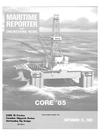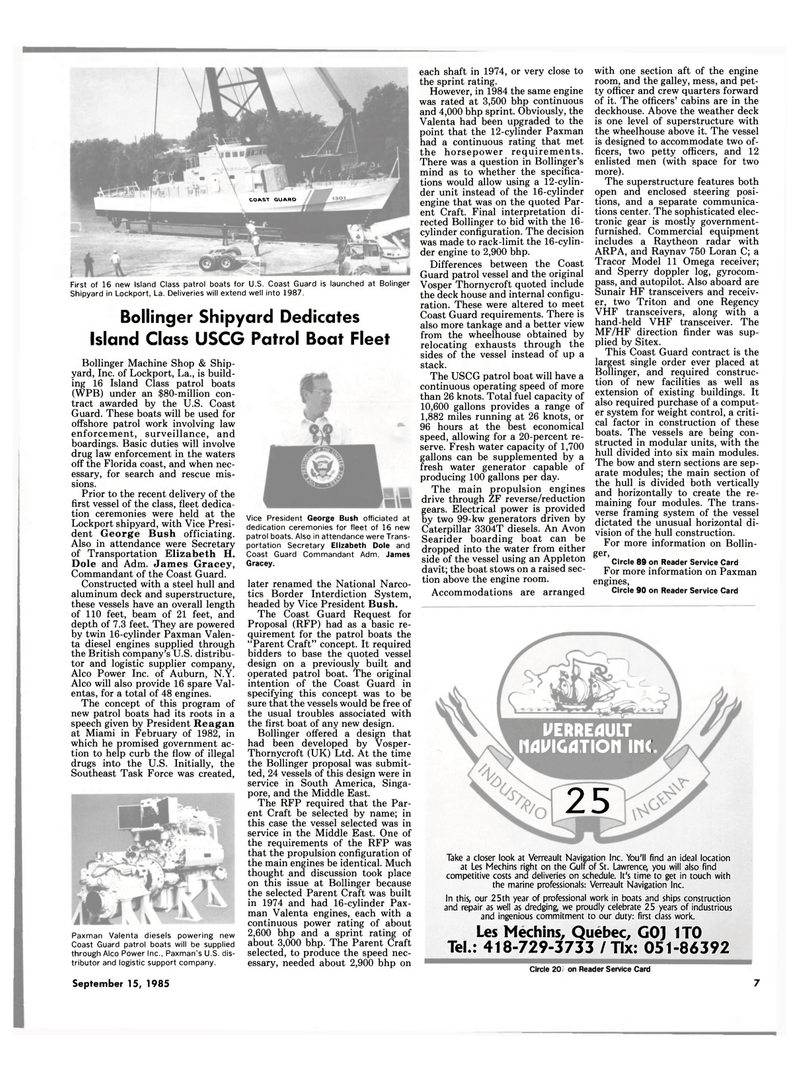
Page 5: of Maritime Reporter Magazine (September 15, 1985)
Read this page in Pdf, Flash or Html5 edition of September 15, 1985 Maritime Reporter Magazine
COAST GUARD
First of 16 new Island Class patrol boats for U.S. Coast Guard is launched at Bolinger
Shipyard in Lockport, La. Deliveries will extend well into 1987.
Bollinger Shipyard Dedicates
Island Class USCG Patrol Boat Fleet
Bollinger Machine Shop & Ship- yard, Inc. of Lockport, La., is build- ing 16 Island Class patrol boats (WPB) under an $80-million con- tract awarded by the U.S. Coast
Guard. These boats will be used for offshore patrol work involving law enforcement, surveillance, and boardings. Basic duties will involve drug law enforcement in the waters off the Florida coast, and when nec- essary, for search and rescue mis- sions.
Prior to the recent delivery of the first vessel of the class, fleet dedica- tion ceremonies were held at the
Lockport shipyard, with Vice Presi- dent George Bush officiating.
Also in attendance were Secretary of Transportation Elizabeth H.
Dole and Adm. James Gracey,
Commandant of the Coast Guard.
Constructed with a steel hull and aluminum deck and superstructure, these vessels have an overall length of 110 feet, beam of 21 feet, and depth of 7.3 feet. They are powered by twin 16-cylinder Paxman Valen- ta diesel engines supplied through the British company's U.S. distribu- tor and logistic supplier company,
Alco Power Inc. of Auburn, N.Y.
Alco will also provide 16 spare Val- entas, for a total of 48 engines.
The concept of this program of new patrol boats had its roots in a speech given by President Reagan at Miami in February of 1982, in which he promised government ac- tion to help curb the flow of illegal drugs into the U.S. Initially, the
Southeast Task Force was created,
Paxman Valenta diesels powering new
Coast Guard patrol boats will be supplied through Alco Power Inc., Paxman's U.S. dis- tributor and logistic support company.
Vice President George Bush officiated at dedication ceremonies for fleet of 16 new patrol boats. Also in attendance were Trans- portation Secretary Elizabeth Dole and
Coast Guard Commandant Adm. James
Gracey. later renamed the National Narco- tics Border Interdiction System, headed by Vice President Bush.
The Coast Guard Request for
Proposal (RFP) had as a basic re- quirement for the patrol boats the "Parent Craft" concept. It required bidders to base the quoted vessel design on a previously built and operated patrol boat. The original intention of the Coast Guard in specifying this concept was to be sure that the vessels would be free of the usual troubles associated with the first boat of any new design.
Bollinger offered a design that had been developed by Vosper-
Thornycroft (UK) Ltd. At the time the Bollinger proposal was submit- ted, 24 vessels of this design were in service in South America, Singa- pore, and the Middle East.
The RFP required that the Par- ent Craft be selected by name; in this case the vessel selected was in service in the Middle East. One of the requirements of the RFP was that the propulsion configuration of the main engines be identical. Much thought and discussion took place on this issue at Bollinger because the selected Parent Craft was built in 1974 and had 16-cylinder Pax- man Valenta engines, each with a continuous power rating of about 2,600 bhp and a sprint rating of about 3,000 bhp. The Parent Craft selected, to produce the speed nec- essary, needed about 2,900 bhp on each shaft in 1974, or very close to the sprint rating.
However, in 1984 the same engine was rated at 3,500 bhp continuous and 4,000 bhp sprint. Obviously, the
Valenta had been upgraded to the point that the 12-cylinder Paxman had a continuous rating that met the horsepower requirements.
There was a question in Bollinger's mind as to whether the specifica- tions would allow using a 12-cylin- der unit instead of the 16-cylinder engine that was on the quoted Par- ent Craft. Final interpretation di- rected Bollinger to bid with the 16- cylinder configuration. The decision was made to rack-limit the 16-cylin- der engine to 2,900 bhp.
Differences between the Coast
Guard patrol vessel and the original
Vosper Thornycroft quoted include the deck house and internal configu- ration. These were altered to meet
Coast Guard requirements. There is also more tankage and a better view from the wheelhouse obtained by relocating exhausts through the sides of the vessel instead of up a stack.
The USCG patrol boat will have a continuous operating speed of more than 26 knots. Total fuel capacity of 10,600 gallons provides a range of 1,882 miles running at 26 knots, or 96 hours at the best economical speed, allowing for a 20-percent re- serve. Fresh water capacity of 1,700 gallons can be supplemented by a fresh water generator capable of producing 100 gallons per day.
The main propulsion engines drive through ZF reverse/reduction gears. Electrical power is provided by two 99-kw generators driven by
Caterpillar 3304T diesels. An Avon
Searider boarding boat can be dropped into the water from either side of the vessel using an Appleton davit; the boat stows on a raised sec- tion above the engine room.
Accommodations are arranged with one section aft of the engine room, and the galley, mess, and pet- ty officer and crew quarters forward of it. The officers' cabins are in the deckhouse. Above the weather deck is one level of superstructure with the wheelhouse above it. The vessel is designed to accommodate two of- ficers, two petty officers, and 12 enlisted men (with space for two more).
The superstructure features both open and enclosed steering posi- tions, and a separate communica- tions center. The sophisticated elec- tronic gear is mostly government- furnished. Commercial equipment includes a Raytheon radar with
ARPA, and Raynav 750 Loran C; a
Tracor Model 11 Omega receiver; and Sperry doppler log, gyrocom- pass, and autopilot. Also aboard are
Sunair HF transceivers and receiv- er, two Triton and one Regency
VHF transceivers, along with a hand-held VHF transceiver. The
MF/HF direction finder was sup- plied by Sitex.
This Coast Guard contract is the largest single order ever placed at
Bollinger, and required construc- tion of new facilities as well as extension of existing buildings. It also required purchase of a comput- er system for weight control, a criti- cal factor in construction of these boats. The vessels are being con- structed in modular units, with the hull divided into six main modules.
The bow and stern sections are sep- arate modules; the main section of the hull is divided both vertically and horizontally to create the re- maining four modules. The trans- verse framing system of the vessel dictated the unusual horizontal di- vision of the hull construction.
For more information on Bollin- ger,
Circle 89 on Reader Service Card
For more information on Paxman engines,
Circle 90 on Reader Service Card
UERRE4ULT
IMMIGdTIOVI IV1C 25
Take a closer look at Verreault Navigation Inc. You'll find an ideal location at Les Mechins right on the Gulf of St. Lawrence, you will also find competitive costs and deliveries on schedule. It's time to get in touch with the marine professionals: Verreault Navigation Inc.
In this, our 25th year of professional work in boats and ships construction and repair as well as dredging, we proudly celebrate 25 years of industrious and ingenious commitment to our duty: first class work.
Les Mechins, Quebec, GO] 1T0 Tel.: 418-729-3733 / Tlx: 051-86392
Circle 200 on Reader Service Card
September 15, 1985 7

 4
4

 6
6
